- Your source for stall mats, rubber arena footing, arena harrows and arena dust control.
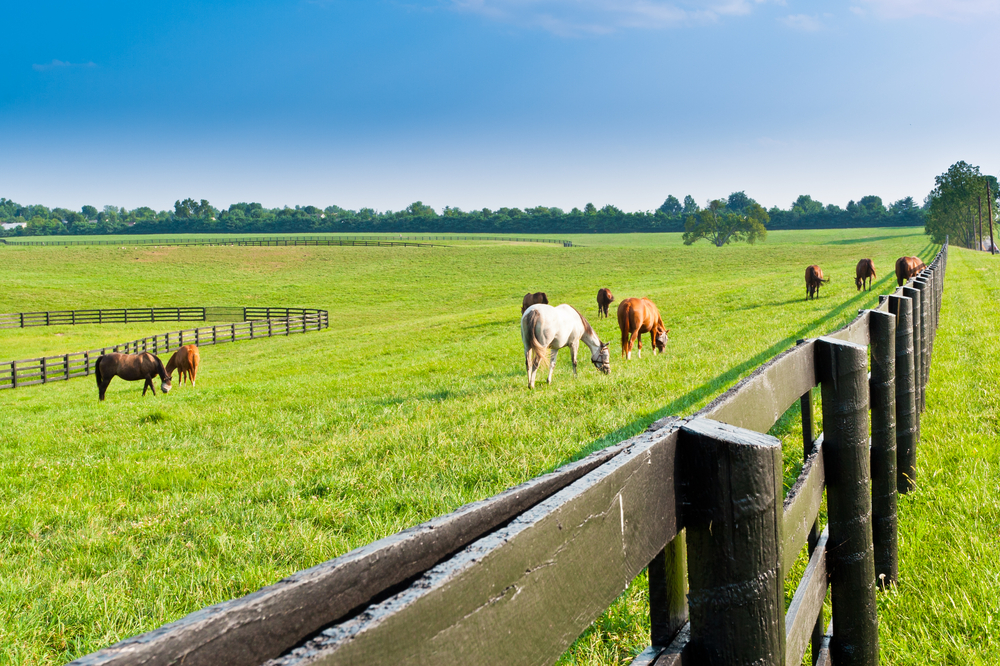
We owe it to our horses to provide an environment where they feel safe and secure and provide their nutritional, mental, and physical well-being. So just what kind of living environment does a horse need to live a happy, healthy life?
There are two main things horses need for their living environment; a safe outdoor space to run around and graze and access to a shelter to protect them from sun, wind, rain, and snow. It is recommended that horses have access to a fully enclosed barn or stable with adequate ventilation in colder climates.
Your horse’s living environment is an important part of maintaining your horse and keeping them healthy and happy. In this article, you can find advice about providing a suitable environment for your horse to live in, including shelter and pasture.
and keeping them healthy and happy. In this article, you can find advice about providing a suitable environment for your horse to live in, including shelter and pasture.
Pastures
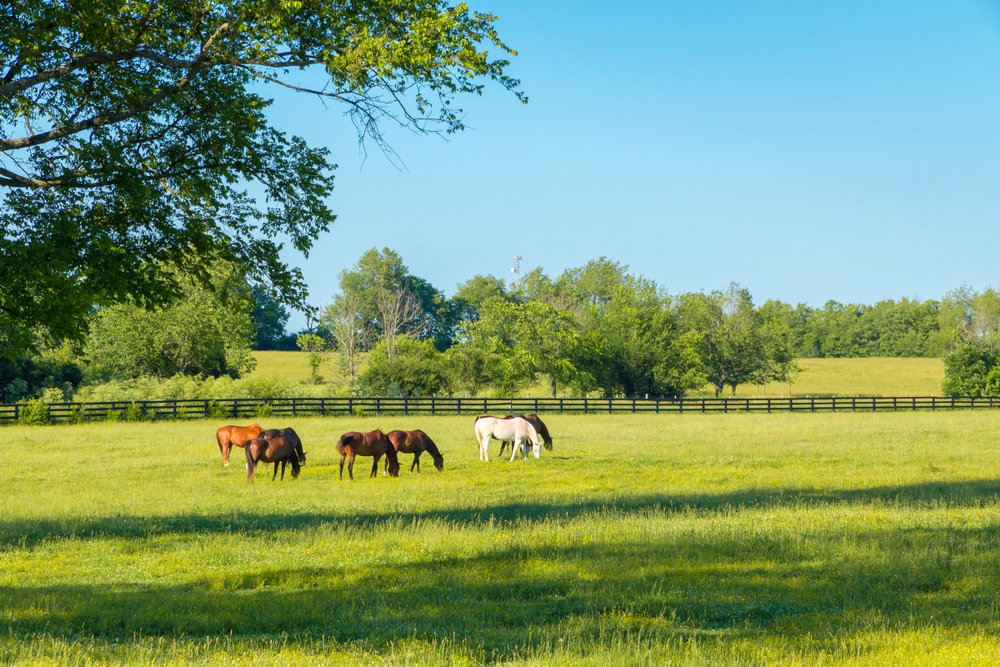
PASTURE DEFINITION
Non-thoroughbred horses are quite capable of living out to grass all year round, but it is your responsibility to provide for your horse’s needs.
Ideally, pasture grass should be rested, sprayed for weeds, and fertilized and managed for worms. One acre per horse is the estimate for keeping a horse at grass. By carrying out pasture maintenance, you ensure good quality grazing for as much of the year as possible.
When there is enough grass available in the Spring, this does not present a problem. However, later in the year, over Winter, when the grass growth rate is reduced and does not grow so nutritious, you need to supplement your horse’s diet by providing him with energy foods if he is to stay out at grass.
When your horse is living out in a paddock, you should provide your horse with field shelter. Your horse will be able to find shelter from the wind and sun, rain and snow. During the rainy season, horses will always seek out and use a cover.
Provide your horse company if he is alone in the pasture. Horses are herd animals; it is unkind to keep your horse alone. Sometimes, it is impossible to have a second horse, but you can provide an alternative buddy like a goat or sheep.
How much land do you need for a horse?
To figure out exactly how much land you need for a horse, 1-1/2 to 2 acres of open land per horse would be a good size. If appropriately managed two acres, it would provide adequate forage in the form of pasture.
If your horse gets hay each day and will use the land for exercise rather than for grazing, a smaller area will be just fine. The bare minimum size needed to house a horse for turnout is 0.1 (one-tenth) of an acre, approximately 4,500 square feet or 75 feet x 60 feet for an exercise lot.
Read more for an in-depth look at how much land is needed for a horse .
.
Why is space important for horses?
Providing your horse with a suitable living environment is not just a physical thing but also a mental one. When your horse is happy in his living environment, your horse will be more comfortable in himself and more willing to work. We owe it to our horses to provide them with an environment where our horses feel secure and provide them nutritional, mental, and physical care.
Ideally, we all want 100 acres for our horses to roam on. For many, this is not possible in the real world. However, a small property can offer your horse a natural living environment.
A natural living area should provide your horse with enough space to be in continuous motion except during times of sleep and rest. Horses are made to move continuously, and in the wild, will range a total of ten to fifteen miles per day.
When horses cannot exercise, their body circulation is hindered and will cause problems in their legs and feet. When a horse moves, blood from the lower legs is pumped back through the body to the heart by the hooves, muscles, and tendons.
For a horse to have strong, healthy feet and legs, a horse needs constant movement. This activity also allows the muscles and joints to stretch and strengthen and promotes healthy gut function, helping to reduce the risk of impaction colic.
Many horse owners think that if horses are turned out together, they will hurt each other, but this isn’t true. Horses need to be together; they touch and play with one another. Although they sometimes play games of dominance to determine the herd’s hierarchy, actual contact is minimal. Keeping horses together during turnout promotes movement and so aids healthy activity.
Don’t be afraid to include uneven ground like hills, rocks, fallen logs, shrubs, and trees into your horse’s living environment. It is human nature to think that what we find comfortable is also suitable for our horse. We think we should level the ground and remove rocks and other “dangers.”
However, this means your horse has nothing left to do but mindlessly wander between his water and feed areas. Provide your horse with a living environment full of enrichment that will elevate boredom and mimic a natural environment.
Things to consider for your horse’s outdoor living space
- Water. If your horse is living in an outdoor paddock, it should have shelter and access to freshwater. Hay alone will not provide enough moisture for your horse. A few buckets of water left at the pasture gate are not the answer either; the water can evaporate in hot climates and, during cold weather, freeze over.
- Space. Each horse should have enough space to walk and run around freely when your horse chooses. The two-acre outdoor space should preferably consist of grazing pasture that allows your horse to graze while getting exercise.
- Fence. The outdoor living space should be fenced with materials that cannot easily be knocked or jumped over by your horse. There are various fence materials suitable for horses, like wood, woven wire, pipe fencing. It is not recommended to use barbed wire as it can injure your horse. The paddock fence should be tightly stretched if using wire and should be at least five feet high. The bottom of the paddock fence should be around a foot off the ground so your horse cannot get his hooves trapped in the wire.
- Fence Posts. The fence posts should be on the outside of the horse’s living space to avoid your horse from running into them. Wooden fences need to be inspected regularly to ensure no damaged pieces or protruding parts could injure your horse.
- Toxic Plants. You must know what kind of plants are in your horse’s pasture. Many plants are toxic to horses. Ensure that there are no poisonous plants growing in your horse’s outdoor living space. Your local government agricultural department can tell you what regional plants are toxic to horses if you don’t know.
Types of Fences
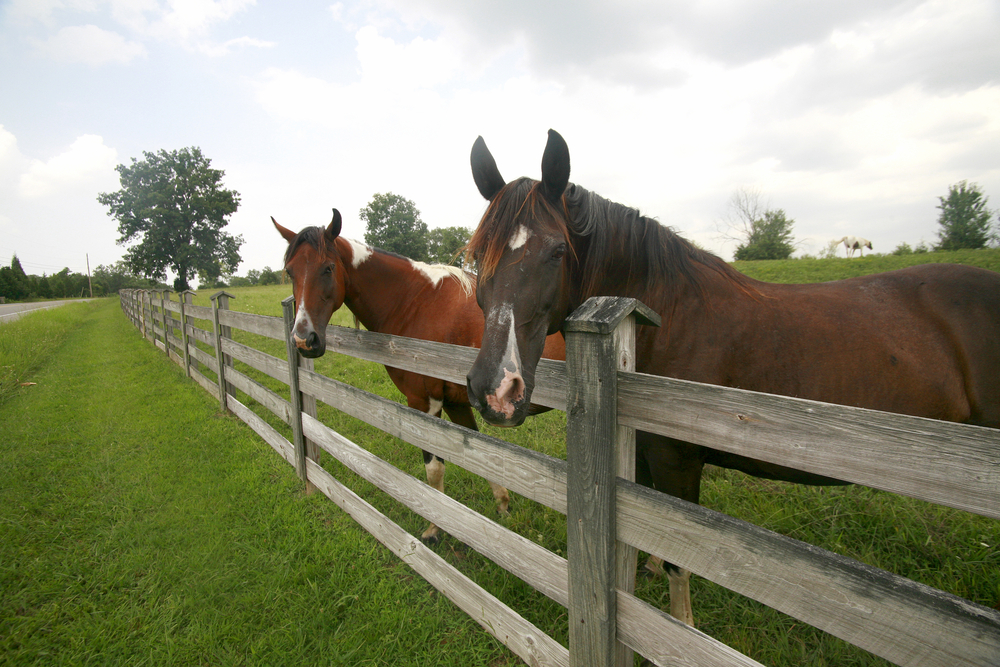
There is no single kind of fence that is best for any horse. Understanding the difference between fences is vital for choosing the right fence to keep your horse safe.
There are many popular types of fences that are used for horses. Before choosing any fence, carefully consider whether it is suitable to your horse, property type, and overall need before committing to one particular fence.
Electric Fences
An electric fence delivers a light shock to a horse when it touches or leans on the fence. Electric fences are generally constructed of coated wire and can be adjusted to different current levels. Unfortunately, they are also one of the most expensive fence types. Electric fences can be less visible to horses, which increases the risk of impacts and tangling.
Wire Fences
Strung wire fences without electrical current are simple and easy to install and one of the less expensive fences. Unfortunately, they are high risk. Horses can get tangled in the wires, and that could lead to severe injuries. These wire fences are not as visible as other types of fences. Wire fences need regular tightening as impacts and other disruptions often loosen them.
Pipe Fences
Pipe fences are strong and relatively visible, and while they require less maintenance, they are also less flexible. A pipe fence cannot be adjusted easily when the fence needs to be reconfigured. Pipe fences can be dangerous for horses. Unfortunately, pipe fences will not flex if a horse runs into and your horse could be more injured.
Wood Rail Fences
Rustic wooden fences are the most popular choice, and they are highly visible. Wooden rail fences are easy to install and are less expensive. However, wooden fences require more maintenance as the wood warps or damaged by horses. The maintenance cost can increase significantly. Unfortunately, the overall lifespan of a wood rail fence is shorter than other types of fences.
Vinyl Rail Fences
Vinyl rail fences mimic the country look of wooden fences. Vinyl rail fences are low maintenance and have a longer lifespan than other fences. Vinyl rail fencing can be more expensive and more difficult to repair when they are broken. These fences are highly visible and are suitable for a wide range of uses, and can work for many horses.
| Type of Fence | Comments |
| Electric Fence | – delivers a light shock to a horse when it touches or leans on the fence. – constructed with coated wire and can be adjusted to different current levels. – expensive. – can be less visible to horses, which increases risk of impacts and tangling. |
| Wire Fence | – simple and easy to install – less expensive. – high risk as horses can get tangled in the wires and lead to severe injuries. – not as visible as other types of fences. – need regular tightening |
| Pipe Fence | – strong – relatively visible – require less maintenance – less flexible. – cannot be adjusted easily when the fence needs to be reconfigured. – can be dangerous for horses. |
| Wood Rail Fence | – most popular choice – highly visible. – easy to install – less expensive. – require more maintenance as the wood warps or damaged by horses. – high maintenance cost – shorter overall lifespan |
| Vinyl Rail Fences | – mimic the country look of wooden fences. – are low maintenance – longer lifespan than other fences. – more expensive – more difficult to repair – highly visible – suitable for a wide range of uses |
Putting in a Fence for your horse
A fence is crucial to keep your horse safe and secure, and there are several types of fencing to choose from. It doesn’t matter what kind of fence you chose for your horse; you must ensure the fence is installed securely and properly maintained.
- Professional installation. Ensure the installer is familiar with the type of horse fence you are installing and that the person is prepared to take extra steps to ensure durability.
- Enclose an adequate area. Consider the possibility of multiple horses sharing the same paddock or corral and plan for the future.
- Plan. When designing a new enclosure, consider all the necessary features for your paddock, like feeding, gate access, watering, and mowing, and position the paddock fence appropriately.
- Fence Height. Your fence should be high enough to contain your horse safely. Taking your horse’s activity level and jumping ability into account, your fence should be 48-60 inches tall.
- Inspect. Keep necessary tools and spare parts on hand to make repairs whenever necessary, and frequently inspect the fence to ensure it is safely maintained.
Barns and Stables
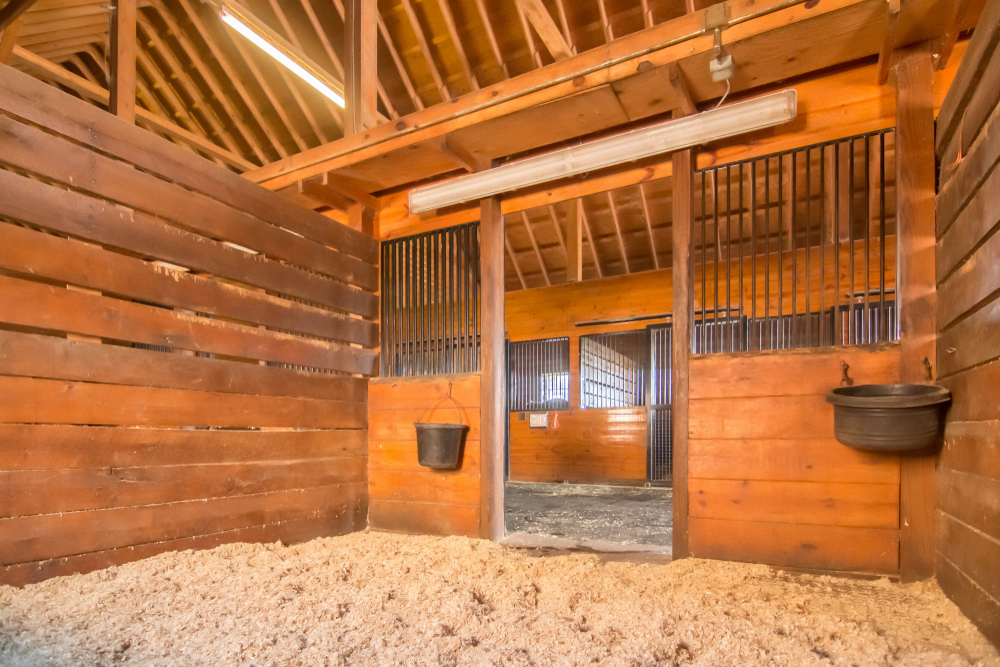
Most horses will spend at least some time residing in a stall during their lifetime. Choosing a barn with proper ventilation and enabling some social interaction in their stables will help keep your horse healthy and help keep their anxiety levels down.
Horses crave social contact, and therefore having them in stalls where they can talk to each other will help relieve boredom and reduce stress levels. Horses will need to at least see each other to prevent separation anxiety, which can cause several behavior problems, as already mentioned.
In a barn-style stable yard, horses are close enough to hear, see, and even touch each other and comfort that they are all together and not separated.
Things to consider for your horse’s stable
- Size. Make sure that your horse’s stable is the right size that can allow them free movement and enough space to lie down and roll without getting injured. Depending on the size of your horse and the length of time your horse spends in the stall will determine stall size. Bigger horses require more square footage than smaller horses do. For a horse to turn around, lie down, and get up comfortably, a 12-foot x 12-foot stall is the standard recommendation.
- Light. A stable should also not be too dark. Having a window or open stall where they can look outside will make them feel less cut-off from their friends.
- Ventilation. There should always be sufficient ventilation in a stable or stall.
- Stable hygiene. Keeping your horses stable clean is also crucial for a happy horse. Make sure the stable gets cleaned out daily, so your horse has a clean dry bed to sleep on and to avoid health and respiratory problems.
- Stable toys. Stable toys are a bit controversial in the sense that horses get used to them and can become bored with them too. So, it comes down to opinion and on the type of horse you have I guess. Regardless, the trick is to try and find a toy that captures and sustains your horse’s attention. At the end of the day, turning them out is the best way to alleviate boredom. You could also try to keep their mouths busy as they are natural grazers and are always looking for things to chew on such as a salt or mineral lick.
Are horses happy in stables?
Although it’s recommended to let your horse spend as much time as possible roaming freely outside in a field or paddock, there may be times your horse needs to be confined to his stable. There are a couple of reasons why horses need to be stabled from time to time, like:
- Lack of winter turnout
- Adverse weather conditions
- Illness or injury
- Quarantine
It is vital to understand that your horse’s physiology demands that he has plenty of exercises each day. The horse is continuously grazing, wandering from pasture to pasture, eating as he goes.
When your horse is continually moving as he grazes outdoors, it keeps pushing the food he eats through his digestive tract. If your horse is not getting enough exercise outdoors, he can suffer from impacted colic.
Horses who are stabled with insufficient ventilation for the whole day can develop respiratory problems, like COPD. Horses suffer psychologically as well as physical problems from being kept stabled for long periods. Horses are gregarious, social animals. Being stabled for long periods and being kept away from other horses can cause stress and boredom.
Horses can quickly develop stable vices, including weaving, cribbing, wood-chewing, and box-walking when they become bored alone in a stable. Most stabled horses habitually kick their stall walls and doors, and they might also become aggressive, taking out their frustrations on their handlers.
Read more on whether horses are happy in stables .
.
How long can your horse stay in a stable?
Horses should never be stabled for more than 10 hours at a time. Sometimes it is necessary under a veterinarian’s order for stable rest in cases of illness or injury.
Horses need to be outdoors; a stable is not a natural environment for extended periods. The longer your horse stays in the stable, the worse it becomes for the horse’s mental and physical health.
By keeping your horse in an enclosed area, you are restricting your horse’s movement and grazing capacity. As a grazer, your horse will spend many hours eating to fulfill your horse’s requirements.
Horses have survived and evolved because of their herd concept; a wild horse that became separated from his herd often perished, so a life of solitary confinement in a stable goes against the grain of horse nature.
Read more on how long horses can stay in a stable .
.
Shelters
You should supply your horse with a shelter that provides shade and relief from biting insects and protecting rain and wind. Your horse should have a well-constructed, three-sided shed into which your horse can retreat at all times if he lives outside in a paddock.
Mobile Field Shelters
Mobile field shelters are the easiest and most practical ways to provide shelter for your horse. Field shelters are functional and easy to use. They can be moved from paddock to paddock and give your pastures time to rest. It is easy to move your mobile field shelter to its new location.
- Size. They are available in a variety of sizes. A shelter that houses one horse should be at least 12-by-12-foot. If there is more than one horse in a paddock, you should provide a shelter that’s large enough to accommodate all. Generally, it is 240 square feet or 12-by-20 feet for two horses, with an additional 60 square feet per extra horse.
- Height. The height of the shelter should be at least 10 feet to allow for a rearing horse.
- Depth. Standard depths are 12 to 16 feet, and they can be deeper for colder climates.
Outdoor Horse Sheds
Exercise is essential for horses, and the benefits of being able to roam outside versus being in a barn stall are endless for your horse. Horse sheds are a lot less work than a stable. With an outdoor shed, the horse manure is outside and does not require cleaning daily as a horse stable does. An outdoor shed gives your horse the option to go in and out of the shed at free will. This is closer to a horse’s instinct than being closed in a barn stall 24 hours a day.
Horse Trailers
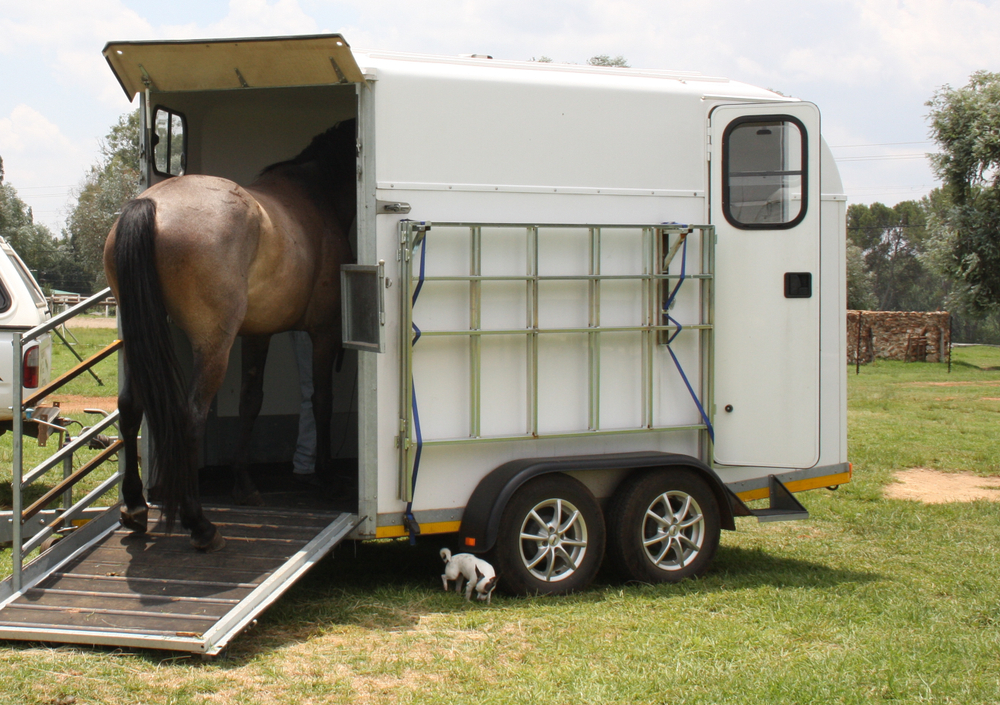
HORSE TRAILER DEFINITION
USES
Can a horse stay in a trailer overnight?
All horse owners find the need to move their horses from one place to another, whether a few miles or a few hundred miles. The more you plan and prepare for the long trip with your horse, the more successful the trip will be.
Generally, horses are fine for 9 hours in a trailer as long as they have food and water. Transport is stressful for horses. Whenever you transport your horse, make sure your horse is comfortable and safe at all times.
Read more on whether horses can stay in a horse trailer overnight .
.
Tips for taking your horse in a trailer on a long-distance journey
The best idea for a long-distance journey with your horse in a trailer is always to have everything mapped and planned out in advance.
Plan the rest stops and determine where your overnight stops will take place. Make this part of your schedule before you leave on a trip.
Most horse owners will plan their trip as far as a month in advance. It’s essential to choose where you are going to make your stops. Frequent stops are not only for your sake but for your horse as well. Finding an excellent fairground to stop over on the way or a location that can provide stables where your horse can relax is always a bargain.
Your horse will need a rest from the trip. Horses can get their nerves ramped up when they are in the trailer out on the road for hours on end. If you allow your horse to rest, it will keep your horse relaxed. So, stop every 4 hours or so.
Tie up your horse in the trailer, so you allow him to get a drink and something to eat while you are driving.
Cover the stall floor with rubber flooring to help with shock-absorbing while traveling. Some dust-free pine shavings on the floor of the trailer will help absorb any urine.
Ensure air circulation in the trailer is sufficient. Having excellent airflow will help your horse stay stress-free and comfortable on the ride.
Can horses live alone, or do they need companions?
In nature, horses naturally live together in herds, and generally, horses are never alone by choice. Living in a herd, horses have many advantages like safety in numbers. Horses are prey animals, and a predator would likely catch a horse living alone in the wild. Therefore, horses feel safer when there are other horses around them.
Most often, horses will take turns to watch over each other while the other horses sleep. One horse usually stands guard when the others are asleep on the ground. This horse is awake and alert while the others sleep.
Horses participate in many social behaviors while together in a herd. These include activities like mutual grooming and playing. Horses mutual groom; they use their incisor teeth to groom each other. This is a fundamental bonding behavior for horses.
Domesticated horses still have the same instincts and behave in the same way that their free-living ancestors. If we ignore these facts about horse’s natural behavior, it can cause them stress. Keeping a horse without a companion is denying your horse his wild herd instincts.
Providing a companion animal for your horse is an excellent way to help your horse when he is all alone in his stable. Horses have bonded with other types of animals like goats, donkeys, mini horses, and sheep.
Read more on whether horses need companions or if they can stay alone .
.
Tips for keeping a horse alone
- Provide a Companion Animal. The best way to keep your horse happy when living alone is to give your horse a companion animal. Goats are the most popular companion animals for horses. Sometimes sheep, cats, and miniature horses are used to ensure that a lonely horse has all the companionship he needs.
- Horse Toys and Other Entertainment. Boredom is a big issue for a horse who is alone. There are many ways that you can help reduce boredom for your horse. Provide your horse with stall toys to keep him entertained in the stable. You can also put horse toys out in your horse’s pasture.
- Promote Movement in the Paddock. Generally, when horses are turned out together, they will move around and play. When your horse is turned out alone, he will be less likely to move around a lot. A good incentive to move is to spread your horse’s feed out in different areas of the pasture. That way, your horse has to walk around as he eats his hay throughout the day.
- Groom Your Horse Frequently. A horse who is kept alone will most definitely miss the mutual grooming that horses do when they are together in a herd. Make an effort to groom your horse regularly. Spend lots of time grooming your horse. This closely resembles the feel of mutual grooming. You may find your horse offers to groom you, too.
- Play a Radio. When you play a radio softly in your stable or barn, it helps break up the silence during the day. Some horses find music soothing. If you decide to play the radio, choose a soft music station, like classical music. Don’t leave the radio plugged in when you are not in the barn.
- Spend Time with Your Horse. You can give your horse companionship and entertainment with just your presence. Spend as much time as you can with your horse every day. If you can’t ride your horse, you can still do activities with your horse like groundwork and hand walking. When your horse is expecting a visit, you can help break the boredom in your horse’s day.
Conclusion
A natural horse living environment may sound like a difficult task to achieve, but it is actually much easier than you might think. You can create a natural living environment for your horse by designing an environment for your horse that is as close as possible to where your horse’s wild counterpart lives. All it takes is the desire to allow your horse to be what he is a horse and understand the basic concepts of horse nature and behavior.
Sources
https://equinewellnessmagazine.com/natural-environment/
https://opensanctuary.org/article/building-a-good-home-for-horses/
https://www.rspca.org.uk/adviceandwelfare/pets/horses/environment
https://www.equinetraining.co.uk/the-environment-for-horses
Other articles in this series:
Feeding Your Horse: A Comprehensive Guide
How To Groom Your Horse: The Ultimate Guide Horse Diseases and Ailments: A Beginners Guide
Horse Diseases and Ailments: A Beginners Guide Horse Veterinary Care: The Complete Guide
Horse Veterinary Care: The Complete Guide

